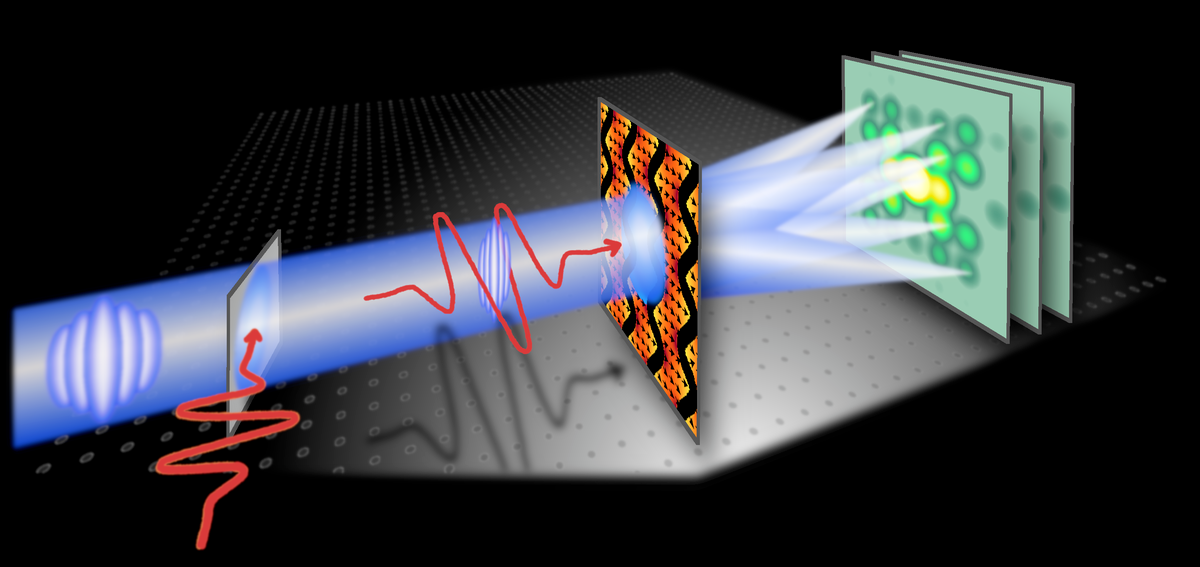Nov 25 2020
Physicists at the University of Konstanz, Ludwig-Maximilians-Universität München (LMU Munich), and the University of Regensburg have been successful in proving that ultrashort electron pulses undergo a quantum mechanical change in phase when they interact with light waves in nanophotonic materials.
 Ultrafast electron diffraction of optically excited metamaterials. Image Credit: Kathrin Mohler, Ludwig-Maximilians-Universität München.
Ultrafast electron diffraction of optically excited metamaterials. Image Credit: Kathrin Mohler, Ludwig-Maximilians-Universität München.
The phase change can reveal the functionality of the nanomaterials. The related experiments and their results have been described in the most recent issue of Science Advances.
Nanophotonic Materials and Metamaterials
A number of materials in nature can impact electromagnetic waves like light in many different ways. But artificial structures called metamaterials are mostly needed to produce unique optical effects to create cloaking devices, efficient solar cells, or catalysts.
These materials acquire their superior properties via advanced structuring at the nanoscale, that is, by means of a grid-like assembly of the smallest building blocks on length scales much below the excitation wavelength.
The characterization and creation of these metamaterials necessitate a deep insight into how the incident light waves act when they hit these minute structures and how they interact with them.
Accordingly, it is essential to measure the optically excited nanostructures and their electromagnetic near fields at spatial resolutions in the range of nanometers (~10−9 m) and, simultaneously, at temporal resolutions below the period of the excitation cycle (~10−15 seconds). But this cannot be realized with just traditional light microscopy.
Ultrafast Electron Diffraction of Optically Excited Nanostructures
Contrary to light, electrons possess a rest mass and thus deliver 100,000 times better spatial resolution compared to photons. Thanks to their charges, electrons can be employed to probe electromagnetic fields and potentials.
At present, a team of researchers headed by Professor Peter Baum (University of Konstanz) has successfully used very short electron pulses to realize such a measurement. For this, they compressed the duration of the electron pulses in time using terahertz radiation such that they could resolve, in-depth, the optical oscillations of the electromagnetic near fields at the nanostructures.
High Spatial and Temporal Resolutions
The challenge involved with this experiment lies in making sure that the resolution is sufficiently high both in space and in time. To avoid space charge effects, we only use single electrons per pulse and accelerate these electrons to energies of 75 kiloelectron volts.
Peter Baum, Study Last Author and Professor, Department of Physics, University of Konstanz
Baum is also the head of the working group for light and matter at the university.
When the extremely short electron pulses are scattered by the nanostructures, they tend to interfere with themselves because of their quantum mechanical properties and produce a diffraction image of the sample.
Interaction with the Electromagnetic Fields and Potentials
The study of the optically excited nanostructures is based on the established principle of pump-probe experiments. Following the optical excitation of the near fields, the ultrashort electron pulse reaches a defined point in time and quantifies the time-frozen fields in time and space.
According to the predictions of Aharonov and Bohm, the electrons experience a quantum mechanical phase shift of their wave function when travelling through electromagnetic potentials.
Kathrin Mohler, Study First Author and Doctoral Researcher, LMU Munich
Such optically induced changes in phase offer data regarding the ultrafast dynamics of light at the nanostructures, eventually providing a movie-like series of images, which discloses the interaction of light with the nanostructures.
A New Application Regime for Electron Holography and Diffraction
These experiments show how electron holography and diffraction can be leveraged in the future to gain better insights into the fundamental light-matter interactions behind metamaterials and nanophotonic materials. In the long run, this may even pave the way to the creation and optimization of compact optics, efficient catalysts, or innovative solar cells.
Journal Reference:
Mohler, K. J., et al. (2020) Ultrafast electron diffraction from nanophotonic waveforms via dynamical Aharonov-Bohm phases. Science Advances. doi.org/10.1126/sciadv.abc8804.